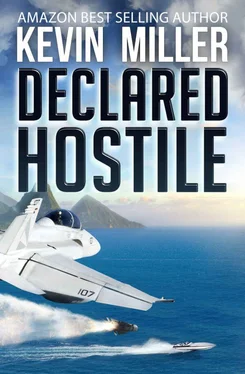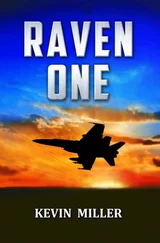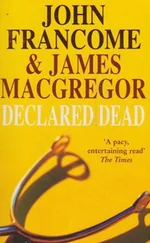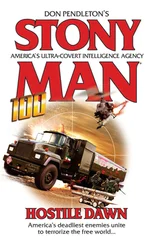“One mile effectively , and we believe it needs 15–50 kilowatts to build a charge. Not sure how long a yacht would take to build up a charge, or if it’s capable of more than blinding a pilot. We suspect a Russian design — there is evidence they are working with the cartels on a variety of high-tech projects — but that distance is an estimate. We’ve tested a laser weapon with a range of ten miles.”
Wilson pursed his lips and nodded. “Thanks, Shane. If you and the other spies can relay the likelihood of a burn-through capability, and any sanctuaries we can exploit, then get that relayed to us through CDC.”
“Yes, sir.”
“Thanks. Okay, gas. The ship is going to add on a tanker after we leave, but don’t bet on it. Manage your fuel, and, if you have to come back, do it. If they send us a tanker or two, we’ll play it by ear about who gets what. We need to keep at least two of us overhead. We can also expect the Raiders and Hobos to send some jets down to relieve us after about 30–45 minutes.”
The pilots nodded.
“All right. Anything else?”
The pilots shook their heads. All were ready to get airborne and on top of the yacht.
“OK, pass your aircraft lineups to your ready rooms. We need to get airborne in less than 30 minutes. If you only get one bomb or half a load of bullets, take the jet anyway. If you don’t get any chaff or flares, take it.”
The pilots wished each other well. “Nice job, Flip, Semper Gumby!” Billy told him with a smile.
“You got that right. Good hunting down there. We gotta move,” Wilson answered.
Good hunting!” Billy said as he led his squadron out of the Firebird ready room.
Wilson noted the time: 1345. He grabbed his helmet bag and went next door to maintenance control to check out his jet, 301. Olive followed him.
“Good brief, Skipper. We’ll catch these guys. Do you think they’re Colombian?”
“Maybe. Maybe Venezuelan, or maybe not even from the western hemisphere.”
Olive nodded as she reviewed her discrepancy book and then noticed that the Maintenance Control Chief and two sailors were listening to their conversation. The Chief spoke.
“Skipper, are you going to find the guys that blinded Lieutenant James? Is there a fleet we are fighting out here?”
Wilson shook his head. “There’s a contact of interest south of us that we need to check out, and it’s not a combatant. We have a small boy with a drone nearby, and we’re going to support them. As soon as we can get up there and started, we are going. So tell the guys on the roof, chop, chop.”
“Yes, sir, they’re ready for you! You’re on the bow.”
“Thanks, Chief,” Wilson said and smiled as he signed the book. He then grabbed his helmet bag and hurried for the paraloft. They had little more than an hour to go.
(Flight deck, USS Coral Sea )
A determined Wilson moved up the flight deck in long strides, leaning into the 30-knot wind. He saw Billy get into his assigned jet, 404, next to the Cat 1 jet blast deflector. Wilson’s jet was three up from him, with Olive next to Wilson in 303. Dusty and Ripper were starting someplace aft, with Coach as the spare. The red-shirted ordnancemen continued to wheel 500-pounders into place under the wing racks of the jets and to crank 20mm rounds through the feeder mechanisms. Wilson knew he did not have time to wait on them to finish. Whatever was hanging from his jet was what he was going to have to take.
The ordies were manually lifting the bombs into place on the weapon pylons of 301 when Wilson arrived. He caught the attention of Gunner Short, the Ordnance Officer.
“Gunner, we have no time. After I preflight this jet, I’m starting it up.”
Worried, Gunner responded. “OK, Skipper, we’re going to connect this one on station two and load up eight as fast as we can.”
“Do it!”
Wilson preflighted the aircraft in practiced sequence, thinking about the yacht, the SEALS in the helos, CAG’s intensity. He had not awakened this morning expecting to expend weapons in anger on a vessel underway, much less a pleasure craft. With Trench blind, the combat capability of the Firebirds was degraded, but Weed could fill a flight schedule slot. Wilson would let a jet go empty before placing that sonofabitch Mongo in it.
Weed. Century Ratchet. This was the reason they were down here, the reason Trench was blind, not knowing of the quasi-war Weed and the “testers” were fighting in secret. Secret? To keep it from the press or from operational security? Wilson suspected the former. If our country knows Venezuela or Colombia or Panama — any of them — is growing and shipping poison to ruin our kids, then blow ‘em out of the water. Wilson would gladly participate. Just declare it, and don’t screw around! Win it! Take Vienna.
Wilson finished his preflight and bounded up the ladder. As he dropped himself into the ejection seat, the plane captain began hooking up his mask and g-suit connections, and the Air Boss yelled something over the 5MC flight deck loudspeaker. As Wilson was hooking up his leg restraints, his eyes met those of Chief Royal, the Ordnance Chief. Royal’s crew was finishing up on station 2, and the laser-guided bomb for station 8 was still in its dolly cradle. They weren’t going to load it in time, and Wilson sensed Royal’s concern.
“Chief, I’m taking it as is. Work on the next jet!” Wilson shouted to him from the cockpit.
Royal nodded. “We did our best, sir.”
Wilson pointed to the nose. “How many rounds have I got?”
Royal lifted him a thumbs-up. “Full up, sir!”
“Great. Thanks, Chief!”
Wilson’s 19-year-old plane captain, Airman Hodges, helped attach the upper Koch fittings to Wilson’s harness as Wilson finished strapping himself into the ejection seat. Conditioned not to ask questions of officers, especially of the Skipper, Hodges couldn’t help himself.
“Sir, are we at war?”
“Maybe. We have reason to believe a vessel south of here attacked Lieutenant James in international waters. We aim to stop it and find out. Hodges, let’s start this thing up now . We’ve gotta move.”
“Yes, sir! Have a good flight, sir!”
Hodges descended the ladder and folded it into the LEX. Wilson caught the attention of a flight deck yellow shirt controller and shook two fingers, the hand signal to start. The yellow shirt nodded, and when Hodges reappeared, Wilson began the start sequence, the first jet on the bow to do so. The flight deck was a scene of confusion as sailors and aircrew darted among the bombs, fuel hoses, and electrical cables in an effort to get the jets started and airborne. Now .
With both engines online, Wilson lowered his canopy and continued turning on radios and navigation systems. On the angled deck and saw the SEALS loading in the two Sierras. Machine guns bristled from the sides of both aircraft, and one Sierra had a Hellfire missile attached. The ship was pounding south through the gentle swells at thirty knots to close the distance to the yacht. Wilson guessed, at launch, his quarry would be about 100 miles south. He could make that in roughly ten minutes.
The flight deck, under time pressure to get the aircraft airborne, was a scene of controlled confusion as the red-shirted ordnancemen and white-shirted troubleshooters jockeyed for position on their jets. Wilson smiled at the thought that the sandlot “football payers” he’d talked to a moment ago now sat in their jets with technicians around them as if involved in a NASCAR pit stop. The yellow shirts and blue shirts, impatient to get the jets off the bow, milled about near the aircraft as they were being prepared. The green-shirted cat crews were also impatient to move the jets off their catapults.
Читать дальше












